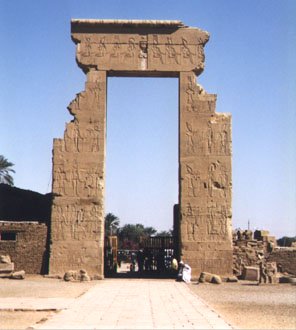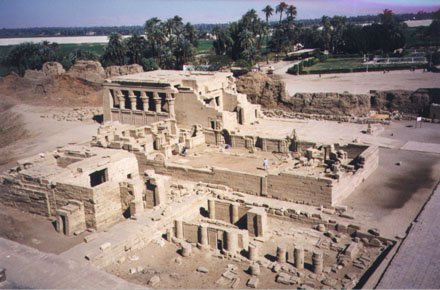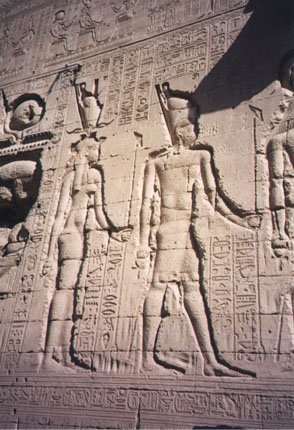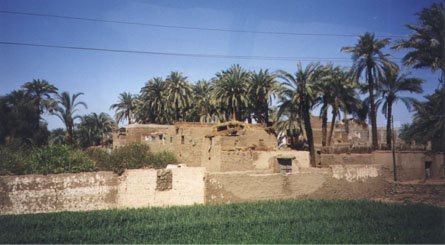DENDERA

Dendera is the modern name given to the ruins of ancient Tentyra, a site dating
all the way back to the Old Kingdom. We left the cruise ship in a bus that had to be
escorted by a pair of Egyptian army jeeps full of men with AK-47 automatic rifles, since
the journey was considered too dangerous to be taken alone by tourists. I don't know if
they were worried about terrorists or bandits, but they got us there and back with no
problem. Above is the huge broken gateway at the entrance to the site, which is missing
its accompanying wall that it was once attached to. An Egyptian man (in light blue robe)
gives it scale by standing just inside to the right.
The main building of interest at Dendera is the Temple of Hathor (the cow-headed
goddess of fertility). This temple was reconstructed by the Romans during their occupation
of Egypt. It is therefore regarded as a rather new temple (compared to the majority of
ancient Egyptian ruins), but it is also one of the better preserved, and is well worth the
time to visit. Not all tours go here, since it is above Luxor and most cruise ships don't
go that far north. The large openings on the front of the temple are covered with iron
gratings (hard to see in this photo), and its size can be judged by the seven foot high
doorway at the bottom center of the front wall. The outside pillars are crowned with the
head of Hathor, though her face is missing from the exterior ones, it can be seen better
on the interior pillars. Incidently, though referred to as "cow-headed", she is
usually depicted as having a human head with cow ears.

This is the view from the roof of the temple looking down towards other buildings
at the site. In the back is a tall building with open columned walls that is known as the
"mamisi", which is a Roman birth house. Obviously most of these structures are
incomplete and not fully restored. In the lower right corner is the paved walkway that
goes up to the large gateway shown earlier, and down to the temple of Hathor upon which we
are standing.

This is a section of the rear exterior wall of the main temple. Like many of the
wall murals in Egyptian temples, the faces of the figures have been hacked away by the
early Christians who later occupied these sites. In some cases they chipped away the
figure's entire details, leaving nothing but an outline of what was there. As an amateur
archeologist this kind of thing really pisses me off, but it was typical of the times.
When I think of all the historic art and knowledge that have been destroyed "in the
name of God" it makes me sick. Luckily this site made out relatively well, compared
to others that we saw.
This is a mural from down inside one of Dendera's crypts. It has been
said by some to represent the use of light bulbs in ancient Egypt (note the long tubular
objects with the snake-like filament inside). Check out these webpages for the PROS
and CONS of this
radical concept.

Taken from inside the bus on the way back from Dendera, this is a typical mud-brick
village in Egypt. The process of making mud bricks hasn't changed in thousands of years,
and still provides a low-cost method of building, which is frequently seen outside of the
major cities.